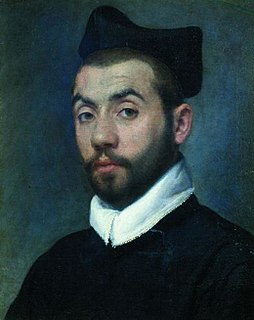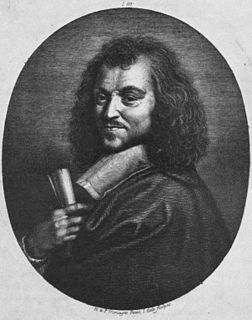
Clément Marot was a French Renaissance poet.
This article contains information about the literary events and publications of 1544.
This article contains information about the literary events and publications of 1532.

Daniel Marot or Daniel Marot the Elder (1661–1752) was a French architect, furniture designer and engraver at the forefront of the classicizing Late Baroque "Louis XIV" style. He worked for a long time in England and the Dutch Republic.
David or Dave Martin may refer to:
The grands rhétoriqueurs or simply the "rhétoriqueurs" is the name given to a group of poets from 1460 to 1520 working in Northern France, Flanders, and the Duchy of Burgundy whose ostentatious poetic production was dominated by (1) an extremely rich rhyme scheme and experimentation with assonance and puns and (2) experimentation with typography and the graphic use of letters, including the creation of verbal rebuses. The group is also credited with promoting alternation between "masculine" rhymes and "feminine" rhymes.
Jean Marot was a French poet and the father of the French Renaissance poet Clément Marot. He is often grouped with the "Grands Rhétoriqueurs".

The Genevan Psalter, also known as The Huguenot Psalter, is a metrical psalter in French created under the supervision of John Calvin for liturgical use by the Reformed churches of the city of Geneva in the sixteenth century.
Antoine is a French given name that is a variant of Danton, Titouan, D'Anton and Antonin used in France, Switzerland, Belgium, Canada, West Greenland, Haiti, French Guiana, Madagascar, Benin, Niger, Burkina Faso, Ivory Coast, Guinea, Senegal, Mauritania, Western Sahara, Morocco, Algeria, Tunisia, Chad, Central African Republic, Cameroon, Equatorial Guinea, Gabon, Republic of the Congo, Democratic Republic of the Congo, Burundi, and Rwanda. The name is a cognate of the masculine given name Antony, and the feminine form is Antoinette.

Pierre Le Muet was a French architect, military engineer, and writer, famous for his book Manière de bâtir pour toutes sortes de personnes, and for the châteaux he constructed, most notably Tanlay in Burgundy, as well as some modest houses in Paris, the grandest of which, the Hôtel d'Avaux (1644-1650) survives and has recently been restored to a semblance of its seventeenth-century condition.
Events from the year 1730 in art.
Nationality words link to articles with information on the nation's poetry or literature.
Nationality words link to articles with information on the nation's poetry or literature.
Nationality words link to articles with information on the nation's poetry or literature.

Jean Marot was a French architect and engraver of architectural views. Little has survived of his own architectural work, but his engravings of the works of others, primarily those published in the volumes referred to as the Petit Marot and the Grand Marot (1686), were highly esteemed by his contemporaries and remain, despite numerous inaccuracies and distortions, among the most important sources concerning architecture in France up to the early part of the reign of Louis XIV.
Events from the year 1544 in France.
Clement is a French surname a form of the Late Latin name Clemens. Clément is a French form of the same name. People with those given names or surnames include:

The Hôtel du Plessis-Guénégaud was a French aristocratic townhouse, built 1630–1632 for the financier Louis Le Barbier to the designs of architect Clément Métezeau. It was located at what is now 13 Quai Malaquais in the 6th arrondissement of Paris. The site had been owned from 1628 by Auguste de Loménie, Sieur de la Ville-aux-Clercs, who had become the Count of Brienne from his marriage in 1623 to Louise de Bréon. His hôtel is shown as Hôtel de Brienne on the 1652 Gomboust map of Paris. Subsequently it was kown by other names, including Hôtel de Conti (1660–1670), Hôtel du Plessis-Guénégaud, Hôtel de Créquy (1680–1712), Hôtel de Lauzun (1712–1733), Hôtel de La Roche-sur-Yon, and Hôtel Mazarin. It became the property of the state during the French Revolution but in 1818 was returned to its former owners, who demolished it in 1843. The property was acquired by the École des Beaux-Arts in 1858, and Félix Duban began construction of the Bâtiment des Expositions, which was completed in 1862.

The Hôtel de Chevreuse was an aristocratic townhouse in Paris, France. It was built 1622–1623 to the designs of the architect Clément Métezeau for Claude of Lorraine, Duke of Chevreuse and was located on the west side of the rue Saint-Thomas-du-Louvre on a site now part of the Cour Napoléon on the west side of the Louvre. The hôtel is depicted on the 1652 Gomboust map of Paris with an entrance screen and a central porte cochère on the rue Saint-Thomas-du Louvre, a cour d'honneur with two lateral wings and a corps de logis between the entrance court and a large garden, which runs all the way to the rue Saint-Niçaise on the west. It became the Hôtel de Longueville in 1662 and was engraved by Jean Marot. It is also shown in a somewhat different configuration on the Turgot map of Paris, published in 1739. The hôtel was destroyed in 1834.






